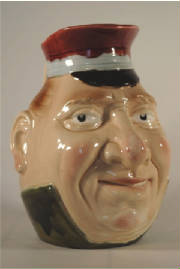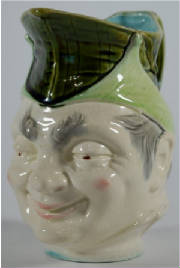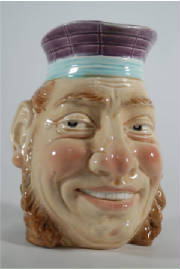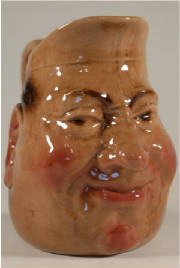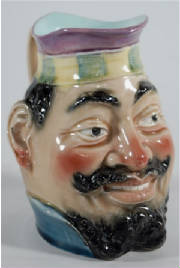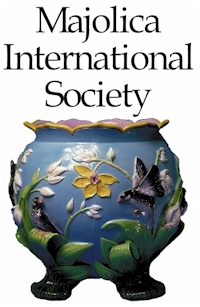A
Brief History of the Character Pitcher
(or "Jug" for my friends across the pond)
Origin of the character pitcher: Though the English Toby jug may be better known, it owes its basic
form to a faience jug that became popular in the Netherlands, Flanders, and the north of France in the 1500's, more than
200 years before the first Toby appeared on English shores. While the official history of these Delft pitchers is lost to
time, the legend of their origin lives on. Their creation is credited to the colorful and romantic Jacqueline de Baviére
(b. 1401; d. 1436), the countess of Hainaut, Zeeland, and Holland. 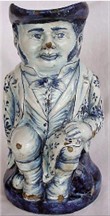
A Romantic Beginning: During
a conflict with her cousin and arch-rival, Phillip of Burgundy, over control of her lands, Jacqueline was taken prisoner by
Phillip and stashed in the donjon of his castle at Ghent. While imprisoned, Jacqueline is said to have amused herself by fashioning
pottery pots or jugs in the form of a seated man or woman and tossing them down from her cell to the townspeople below. (Could
this have been some sort of communication between Jacqueline and her numerous supporters?) Certainly there must have been
some sort of communication because in September 1425 two knights arrived at Phillip's castle at Ghent and managed to slip
a disguise to 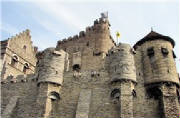 Jacqueline. She escaped the donjon in the guise of a man and made her way to Gouda. This marked the beginning of a
valiant three year effort by Jacqueline to regain control of her lands. Jacqueline was no demure hot-house flower: as comfortable
in full armor as she was in silk robes, she led her own troops into battle, and, against the overwhelming might of Burgundy,
fought courageously on the battlefield to preserve the lands which were her heritage. (If you'd like to learn more about
the colorful heroine, Jacqueline, there's a brief biography of her here.)
Jacqueline. She escaped the donjon in the guise of a man and made her way to Gouda. This marked the beginning of a
valiant three year effort by Jacqueline to regain control of her lands. Jacqueline was no demure hot-house flower: as comfortable
in full armor as she was in silk robes, she led her own troops into battle, and, against the overwhelming might of Burgundy,
fought courageously on the battlefield to preserve the lands which were her heritage. (If you'd like to learn more about
the colorful heroine, Jacqueline, there's a brief biography of her here.)
By the mid-1500's, little faience jugs in the form of a seated man or woman
became popular in the Netherlands, Flanders, and the north of France, and were known as "Pots Jacquelines" if in
the shape of a woman, or "Pots Jacquots" if in the shape of a man. Thus, her name and her courage were commemorated
and live on to this day in France with the charming little human-shaped faience pots and jugs which are still known as "Pots
Jacquelines" and "Pots Jacquot", recalling the romantic story of an imprisoned countess tossing them from her
donjon cell to her loyal followers six hundred years ago.
The "Toby" makes its first appearance: The next major development in character
jugs was the first appearance of the ubiquitous English Toby jug made by the Staffordshire pottery of Ralph Wood around the
year 1762. No one seems to know for sure the origin of the "Toby" name. It may be from the archaic 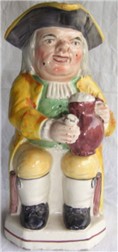 English word "tope" or "to tope" which meant to drink habitually to excess; it may have come about from
the character Toby Belch in Shakespeare's play, Twelfth Night; or it may have come from the character Toby Shandy in Laurence
Sterne's book, Tristam Shandy which was just published in 1760. Lastly, it may have derived from a legendary Yorkshire
drunkard known as Toby Fillpot (or Philpot) whose real name was Harry Ewles. It probably came about through a combination
of influences: In the first place, Sterne's book was quite popular and the character "Toby" was a favorite,
and it was only a short year later that a popular print came out in England illustrating the famous Toby tippler, captioned
with "Old Toby Philpot, as thirsty a soul as e'er drank a bottle or fathomed a bowl,". Of one thing there's
no question-Toby, whoever he may (or may not) have been, definitely liked his drink and spent quite a bit of time in his cups!
English word "tope" or "to tope" which meant to drink habitually to excess; it may have come about from
the character Toby Belch in Shakespeare's play, Twelfth Night; or it may have come from the character Toby Shandy in Laurence
Sterne's book, Tristam Shandy which was just published in 1760. Lastly, it may have derived from a legendary Yorkshire
drunkard known as Toby Fillpot (or Philpot) whose real name was Harry Ewles. It probably came about through a combination
of influences: In the first place, Sterne's book was quite popular and the character "Toby" was a favorite,
and it was only a short year later that a popular print came out in England illustrating the famous Toby tippler, captioned
with "Old Toby Philpot, as thirsty a soul as e'er drank a bottle or fathomed a bowl,". Of one thing there's
no question-Toby, whoever he may (or may not) have been, definitely liked his drink and spent quite a bit of time in his cups!
Ralph Wood's Toby Jug was the brainchild
of one of the most skilled-and dastardly-artists of the time, the French sculptor, John (Jean) Voyez. No doubt John would
have been quite familiar with the "Pots Jacqueline & Jacquot" of his native land, and the earliest Toby's
are remarkably similar in form to the earlier French jugs, but with a decidedly English flavor to them. He is also known to
have been significantly influenced by the work of Paul-Louis Cyfflé at the faiencerie at Lunéville, France,
which certainly made their share of "Pots Jacqueline & Jacquot".
A Creator as colorful as the "Toby" he created: It's more than a little
ironic that John Voyez is associated with the first Toby jug, as he had more than a few 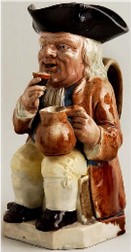 problems of his own due to his propensity for drunkenness. After working for Ralph Wood, Voyez went to work for Josiah Wedgwood
in 1768 with a 3-year contract. Wedgwood was thrilled to have Voyez on his team and wrote enthusiastically about his new hire.
No doubt Wedgwood soon came to rue the day he put the Frenchman on his payroll. Voyez worked for Wedgwood for about a year
when he showed up for work belligerent and drunk. Wedgwood had Voyez flogged and imprisoned at Stafford Gaol for three months.
Wedgwood had just begun to produce the jasperware for which he would become rightly famous, and during Voyez' imprisonment,
he became extraordinarily worried that Voyez would go to work for a competitor when he was released, ending Wedgwood's
virtual monopoly on jasperware. He even proposed paying Voyez the full three years of wages to keep Voyez from going to the
competition. Wedgwood's fears were well-founded: Voyez worked for a time for Palmer of Hanley, but then began his own
workshop, producing the same sort of wares as Wedgwood, and marking them "Wedgwood & Bentley" or "Wadgwojd",
rendered in such as way as to be easily mistaken for "Wedgwood". So the father of the famous Toby jug was a bit
of a ne'er-do-well himself...I don't know if he was nearly so charming as his creation when filled with a pint of
ale!
problems of his own due to his propensity for drunkenness. After working for Ralph Wood, Voyez went to work for Josiah Wedgwood
in 1768 with a 3-year contract. Wedgwood was thrilled to have Voyez on his team and wrote enthusiastically about his new hire.
No doubt Wedgwood soon came to rue the day he put the Frenchman on his payroll. Voyez worked for Wedgwood for about a year
when he showed up for work belligerent and drunk. Wedgwood had Voyez flogged and imprisoned at Stafford Gaol for three months.
Wedgwood had just begun to produce the jasperware for which he would become rightly famous, and during Voyez' imprisonment,
he became extraordinarily worried that Voyez would go to work for a competitor when he was released, ending Wedgwood's
virtual monopoly on jasperware. He even proposed paying Voyez the full three years of wages to keep Voyez from going to the
competition. Wedgwood's fears were well-founded: Voyez worked for a time for Palmer of Hanley, but then began his own
workshop, producing the same sort of wares as Wedgwood, and marking them "Wedgwood & Bentley" or "Wadgwojd",
rendered in such as way as to be easily mistaken for "Wedgwood". So the father of the famous Toby jug was a bit
of a ne'er-do-well himself...I don't know if he was nearly so charming as his creation when filled with a pint of
ale!
Ubiquitous Beer: The primary
purpose of the Pots Jacqueline and Toby Jugs was as a beverage vessel. Clean drinking water was never a sure thing in Europe
or England at this time, so wine, beer, and ale were the most common thirst quenchers. In the middle of the 1700's, gin
was falling out of favor in England as tales of violence and debauch associated with the "gin house" made
the rounds. 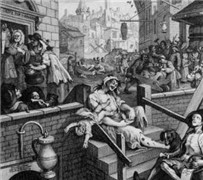 A tax imposed on spirits in 1751, which affected gin but not beer, ale, or wine, helped to sway the populace away from gin
and into the welcoming arms of brewers throughout the continent and England. Brewers thrived and many built public-houses
which functioned more as a community center than a saloon. Mail and messages could be left there for patrons, newspapers were
provided to be enjoyed with a pint. Companies built public-houses for their employees where the workers could pick up their
pay...they could even opt to be paid in beer. Beer dispensers were installed in private homes and the servants consumption
of the brew was counted against their wages. A quick stop at the public-house after work to pick up a large jug of beer to
bring back home to accompany the family dinner was a common occurrence.
A tax imposed on spirits in 1751, which affected gin but not beer, ale, or wine, helped to sway the populace away from gin
and into the welcoming arms of brewers throughout the continent and England. Brewers thrived and many built public-houses
which functioned more as a community center than a saloon. Mail and messages could be left there for patrons, newspapers were
provided to be enjoyed with a pint. Companies built public-houses for their employees where the workers could pick up their
pay...they could even opt to be paid in beer. Beer dispensers were installed in private homes and the servants consumption
of the brew was counted against their wages. A quick stop at the public-house after work to pick up a large jug of beer to
bring back home to accompany the family dinner was a common occurrence.
All this beer-drinking called for a lot of jugs! Patrons of public-houses 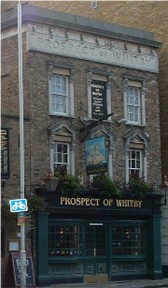 would keep their own personal jug at the "pub", where they were usually stored on a shelf over the bar. Large jugs
were needed for toting the family's ration of beer from the pub to the home, and of course children clamored for jugs
like Mom and Dad's, so small jugs were a necessity as well. With such a profusion of jugs about, it was a good idea to
have a distinctive jug that couldn't be mistaken for someone else's. Potters throughout Europe and England were only
too happy to oblige: Pots Jacqueline (Jacquot) and Tobies in a myriad of styles, sizes, and colors proliferated.
would keep their own personal jug at the "pub", where they were usually stored on a shelf over the bar. Large jugs
were needed for toting the family's ration of beer from the pub to the home, and of course children clamored for jugs
like Mom and Dad's, so small jugs were a necessity as well. With such a profusion of jugs about, it was a good idea to
have a distinctive jug that couldn't be mistaken for someone else's. Potters throughout Europe and England were only
too happy to oblige: Pots Jacqueline (Jacquot) and Tobies in a myriad of styles, sizes, and colors proliferated.
These early Pots Jacqueline and Toby Jugs often had a pottery or
pewter lid attached to keep out flies, and the crown of the traditional Toby's hat was usually removable and served as
a cup. The similarities between the early Pots Jacquot (male jugs) and the first Toby Jugs are significant. Both usually depict
a rotund seated man in full figure and wearing a hat of some sort, usually a tri-corner (especially in the case of the Toby).
The traditional Toby adds a jug to the man's hand and sometimes a cup or pipe to his other hand. In the early 1800's
flasks and bottles in the form of caricatures of current political figures became popular on the continent and England and
soon spread to jugs. Monks were also targeted for their reputed fondness for ale.
The Character Pitcher Arrives: Early on, these jugs still depicted full-body
figures, but by the 1880's the character pitcher depicting just the head, or head and 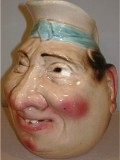 shoulders, had become just as popular as the full-body jug. The famous "grotesques" of Sarreguemines, and the
magnificent bust-like portrait jugs of Frie-Onnaing are prime examples. These were made for quite a number of years,
and enthusiastically copied by hundreds of smaller potters all over the world. The popularity of the form began to wane after
World War I, until they were rediscovered more recently by collectors. They are now being copied just as enthusiastically
as they were a hundred years ago. Unfortunately, unlike most of the earlier copies which, by and large, were not created in
an effort to deceive, most of the modern copies being sold today are made to do just that-to fool the collector into believing
it to be the genuine article. So whether your interest runs to the continental Character jugs from the likes of Sarreguemines
and Frie-Onnaing, or to the storied Toby of England, it behooves the collector to arm oneself with as much knowledge as possible.
shoulders, had become just as popular as the full-body jug. The famous "grotesques" of Sarreguemines, and the
magnificent bust-like portrait jugs of Frie-Onnaing are prime examples. These were made for quite a number of years,
and enthusiastically copied by hundreds of smaller potters all over the world. The popularity of the form began to wane after
World War I, until they were rediscovered more recently by collectors. They are now being copied just as enthusiastically
as they were a hundred years ago. Unfortunately, unlike most of the earlier copies which, by and large, were not created in
an effort to deceive, most of the modern copies being sold today are made to do just that-to fool the collector into believing
it to be the genuine article. So whether your interest runs to the continental Character jugs from the likes of Sarreguemines
and Frie-Onnaing, or to the storied Toby of England, it behooves the collector to arm oneself with as much knowledge as possible.
For more specific information on French character pitchers, such
as those produced by Sarreguemines, Frie-Onnaing, Fives-Lille, and many others, check back here to see the upcoming Part II
of this series: An Online Guide to French Character Pitchers.
Return to Top
Return to Library
Return Home
Bibliography
A History of the County of Stafford:
Volume 8 (1963) in 'Hanley: Local government, economic history and social life',, pp. 157-173. URL: http://www.british-history.ac.uk/report.aspx?compid=53372.
Date accessed: 30 May 2008.
Caricatures
in Pottery. http://www.oldandsold.com/articles/index001.shtml,
Getting to Know Your Toby Jug: Book Review, http://www.ceramicstoday.com/articles/toby.htm,
Stephen Goldate
History of the People of
the Netherlands; Petrus Johannes Blok, Oscar Albert Bierstadt, Ruth Putnam; G.P. Putnam's Sons, New York & London,
1899
Holland from 1299 to 1581: The History
of the Lowlands, http://www.geerts.com/holland/holland-3.htm,L.C. Geerts, May 2007
Jacqueline, Countess of Hainaut, Wikipedia, http://en.wikipedia.org/wiki/Jacqueline,_Countess_of_Hainaut
John, Dauphin of France, Wikipedia, http://en.wikipedia.org/wiki/John,_Dauphin_of_France_(1398-1417)
La céramique: Des exemples de parcours au sein du département
"céramique" du Palais des Beaux-Arts de Lille, 10 Nov 2005, http://netia59a.ac-lille.fr/~siteia/ressources_peda/ecole_culture/docs/html/Ceramique.html,
Palais des Beaux-Arts de Lille
Majolica
Figures, Helen Cunningham, Schiffer Publishing Ltd., Atglen PA, 1997
Pichets en Barbotine: Personnages, Animaux, Fleurs, Maryse Bottero, Editions Charles Massin,
Paris, 2000
The Most Popular Jug In The
World, http://www.collectorcafe.com, April 2000
The
Staffordshire Encyclopedia: Staffordshire's History Online, http://www.the-staffordshire-encyclopaedia.co.uk, Tim
Cockin, 2000
The Toby Jug, http://www.collectorcafe.com,
Laura McGinty, April 2000
Toby & Character
Jugs of the 20th Century and Their Makers: Book Review, Maine Antique Digest
Valois Burgundy, Richard Vaughan, Archon Books, 1975
Wedgwood and His Imitators, N. Hudson Moore, Frederick A. Stokes Company, NY, 1909
Wedgwood China Marks, http://www.pottery-english.com,
"The Expert", September 2006
Copyright 2008: Shantique Gallery


 Jacqueline. She escaped the donjon in the guise of a man and made her way to Gouda. This marked the beginning of a
valiant three year effort by Jacqueline to regain control of her lands. Jacqueline was no demure hot-house flower: as comfortable
in full armor as she was in silk robes, she led her own troops into battle, and, against the overwhelming might of Burgundy,
fought courageously on the battlefield to preserve the lands which were her heritage. (If you'd like to learn more about
the colorful heroine, Jacqueline, there's a brief biography of her
Jacqueline. She escaped the donjon in the guise of a man and made her way to Gouda. This marked the beginning of a
valiant three year effort by Jacqueline to regain control of her lands. Jacqueline was no demure hot-house flower: as comfortable
in full armor as she was in silk robes, she led her own troops into battle, and, against the overwhelming might of Burgundy,
fought courageously on the battlefield to preserve the lands which were her heritage. (If you'd like to learn more about
the colorful heroine, Jacqueline, there's a brief biography of her  English word "tope" or "to tope" which meant to drink habitually to excess; it may have come about from
the character Toby Belch in Shakespeare's play, Twelfth Night; or it may have come from the character Toby Shandy in Laurence
Sterne's book, Tristam Shandy which was just published in 1760. Lastly, it may have derived from a legendary Yorkshire
drunkard known as Toby Fillpot (or Philpot) whose real name was Harry Ewles. It probably came about through a combination
of influences: In the first place, Sterne's book was quite popular and the character "Toby" was a favorite,
and it was only a short year later that a popular print came out in England illustrating the famous Toby tippler, captioned
with "Old Toby Philpot, as thirsty a soul as e'er drank a bottle or fathomed a bowl,". Of one thing there's
no question-Toby, whoever he may (or may not) have been, definitely liked his drink and spent quite a bit of time in his cups!
English word "tope" or "to tope" which meant to drink habitually to excess; it may have come about from
the character Toby Belch in Shakespeare's play, Twelfth Night; or it may have come from the character Toby Shandy in Laurence
Sterne's book, Tristam Shandy which was just published in 1760. Lastly, it may have derived from a legendary Yorkshire
drunkard known as Toby Fillpot (or Philpot) whose real name was Harry Ewles. It probably came about through a combination
of influences: In the first place, Sterne's book was quite popular and the character "Toby" was a favorite,
and it was only a short year later that a popular print came out in England illustrating the famous Toby tippler, captioned
with "Old Toby Philpot, as thirsty a soul as e'er drank a bottle or fathomed a bowl,". Of one thing there's
no question-Toby, whoever he may (or may not) have been, definitely liked his drink and spent quite a bit of time in his cups! problems of his own due to his propensity for drunkenness. After working for Ralph Wood, Voyez went to work for Josiah Wedgwood
in 1768 with a 3-year contract. Wedgwood was thrilled to have Voyez on his team and wrote enthusiastically about his new hire.
No doubt Wedgwood soon came to rue the day he put the Frenchman on his payroll. Voyez worked for Wedgwood for about a year
when he showed up for work belligerent and drunk. Wedgwood had Voyez flogged and imprisoned at Stafford Gaol for three months.
Wedgwood had just begun to produce the jasperware for which he would become rightly famous, and during Voyez' imprisonment,
he became extraordinarily worried that Voyez would go to work for a competitor when he was released, ending Wedgwood's
virtual monopoly on jasperware. He even proposed paying Voyez the full three years of wages to keep Voyez from going to the
competition. Wedgwood's fears were well-founded: Voyez worked for a time for Palmer of Hanley, but then began his own
workshop, producing the same sort of wares as Wedgwood, and marking them "Wedgwood & Bentley" or "Wadgwojd",
rendered in such as way as to be easily mistaken for "Wedgwood". So the father of the famous Toby jug was a bit
of a ne'er-do-well himself...I don't know if he was nearly so charming as his creation when filled with a pint of
ale!
problems of his own due to his propensity for drunkenness. After working for Ralph Wood, Voyez went to work for Josiah Wedgwood
in 1768 with a 3-year contract. Wedgwood was thrilled to have Voyez on his team and wrote enthusiastically about his new hire.
No doubt Wedgwood soon came to rue the day he put the Frenchman on his payroll. Voyez worked for Wedgwood for about a year
when he showed up for work belligerent and drunk. Wedgwood had Voyez flogged and imprisoned at Stafford Gaol for three months.
Wedgwood had just begun to produce the jasperware for which he would become rightly famous, and during Voyez' imprisonment,
he became extraordinarily worried that Voyez would go to work for a competitor when he was released, ending Wedgwood's
virtual monopoly on jasperware. He even proposed paying Voyez the full three years of wages to keep Voyez from going to the
competition. Wedgwood's fears were well-founded: Voyez worked for a time for Palmer of Hanley, but then began his own
workshop, producing the same sort of wares as Wedgwood, and marking them "Wedgwood & Bentley" or "Wadgwojd",
rendered in such as way as to be easily mistaken for "Wedgwood". So the father of the famous Toby jug was a bit
of a ne'er-do-well himself...I don't know if he was nearly so charming as his creation when filled with a pint of
ale! A tax imposed on spirits in 1751, which affected gin but not beer, ale, or wine, helped to sway the populace away from gin
and into the welcoming arms of brewers throughout the continent and England. Brewers thrived and many built public-houses
which functioned more as a community center than a saloon. Mail and messages could be left there for patrons, newspapers were
provided to be enjoyed with a pint. Companies built public-houses for their employees where the workers could pick up their
pay...they could even opt to be paid in beer. Beer dispensers were installed in private homes and the servants consumption
of the brew was counted against their wages. A quick stop at the public-house after work to pick up a large jug of beer to
bring back home to accompany the family dinner was a common occurrence.
A tax imposed on spirits in 1751, which affected gin but not beer, ale, or wine, helped to sway the populace away from gin
and into the welcoming arms of brewers throughout the continent and England. Brewers thrived and many built public-houses
which functioned more as a community center than a saloon. Mail and messages could be left there for patrons, newspapers were
provided to be enjoyed with a pint. Companies built public-houses for their employees where the workers could pick up their
pay...they could even opt to be paid in beer. Beer dispensers were installed in private homes and the servants consumption
of the brew was counted against their wages. A quick stop at the public-house after work to pick up a large jug of beer to
bring back home to accompany the family dinner was a common occurrence.  would keep their own personal jug at the "pub", where they were usually stored on a shelf over the bar. Large jugs
were needed for toting the family's ration of beer from the pub to the home, and of course children clamored for jugs
like Mom and Dad's, so small jugs were a necessity as well. With such a profusion of jugs about, it was a good idea to
have a distinctive jug that couldn't be mistaken for someone else's. Potters throughout Europe and England were only
too happy to oblige: Pots Jacqueline (Jacquot) and Tobies in a myriad of styles, sizes, and colors proliferated.
would keep their own personal jug at the "pub", where they were usually stored on a shelf over the bar. Large jugs
were needed for toting the family's ration of beer from the pub to the home, and of course children clamored for jugs
like Mom and Dad's, so small jugs were a necessity as well. With such a profusion of jugs about, it was a good idea to
have a distinctive jug that couldn't be mistaken for someone else's. Potters throughout Europe and England were only
too happy to oblige: Pots Jacqueline (Jacquot) and Tobies in a myriad of styles, sizes, and colors proliferated.  shoulders, had become just as popular as the full-body jug. The famous "grotesques" of Sarreguemines, and the
magnificent bust-like portrait jugs of Frie-Onnaing are prime examples. These were made for quite a number of years,
and enthusiastically copied by hundreds of smaller potters all over the world. The popularity of the form began to wane after
World War I, until they were rediscovered more recently by collectors. They are now being copied just as enthusiastically
as they were a hundred years ago. Unfortunately, unlike most of the earlier copies which, by and large, were not created in
an effort to deceive, most of the modern copies being sold today are made to do just that-to fool the collector into believing
it to be the genuine article. So whether your interest runs to the continental Character jugs from the likes of Sarreguemines
and Frie-Onnaing, or to the storied Toby of England, it behooves the collector to arm oneself with as much knowledge as possible.
shoulders, had become just as popular as the full-body jug. The famous "grotesques" of Sarreguemines, and the
magnificent bust-like portrait jugs of Frie-Onnaing are prime examples. These were made for quite a number of years,
and enthusiastically copied by hundreds of smaller potters all over the world. The popularity of the form began to wane after
World War I, until they were rediscovered more recently by collectors. They are now being copied just as enthusiastically
as they were a hundred years ago. Unfortunately, unlike most of the earlier copies which, by and large, were not created in
an effort to deceive, most of the modern copies being sold today are made to do just that-to fool the collector into believing
it to be the genuine article. So whether your interest runs to the continental Character jugs from the likes of Sarreguemines
and Frie-Onnaing, or to the storied Toby of England, it behooves the collector to arm oneself with as much knowledge as possible.
